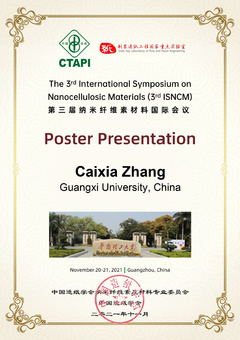Effect of hemicellulose content on the property of CNFs and their films
ID:66
Submission ID:79 View Protection:PRIVATE
Updated Time:2021-11-13 14:48:48 Hits:970
Poster Presentation
Abstract
Cellulose nanofibrils (CNFs) prepared by mechanical grinding are used in the fields of optoelectronics, bio-engineering and membrane science due to their excellent specific surface area, high aspect ratio, low thermal expansion coefficient, easy chemical modification, and good biocompatibility [1-3]. Hemicellulose is an amorphous polymer composed of a variety of sugars and tightly bound to cellulose by a large number of hydrogen bonds. Thus, the presence of hemicellulose in fibers sample will has an important effect on the properties of CNFs and CNFs film. In this study, the bagasse pulp with different hemicellulose contents (17.9 %, 14.4 %, 8.4 %, 4.1 %, and 3.8 %) were firstly prepared by different NaOH solutions (0, 2.0, 5.0, 10.0, 16.0 w/v%) treatment. After that, the pulp samples were fibrillated by an ultrafine grinder for 0, 0.5, 1, 1.5, 2, 2.5, 3 h, respectively, in order to explore the influence of hemicellulose on the fibrillation process of fibers. Finally, CNFs films were prepared by vacuum filtration. The results showed that the appropriate hemicellulose content in pulp was beneficial to the fibrillation process of fibers and the properties of CNFs films. When the pulp was treated with 5 w/v% NaOH solution and the content of hemicellulose in pulp was 8.4%, the yield of CNFs was the highest for 35.1% in all samples under grinding for 2.5 h, and the smallest size of CNFs about 66.32 nm was simultaneously obtained. While further reducing the content of hemicellulose, the size of CNFs was increased and the yield of CNFs was decreased due to the increase of cellulose radicals number and the agglomeration between fibers. Additionally, with the extension of mechanical grinding time, the yield of CNFs showed an obvious upward trend. Until the grinding time exceeded 2.5 hours, the increase in the yield of CNFs slowed down significantly. On the other hand, after the content of hemicellulose in pulp was decreased to 4.1%, the cellulose crystalline structure of pulp samples treated with 10 w/v% or more NaOH solution was partly changed from cellulose I to II, resulting in the interface compatibility being poor as a result of the opposite polarity of cellulose I and II and the block-shaped cellulose and pore being producing during the preparing process of CNFs films. And the thermal stability of the CNFs films were increased and reached the maximum thermal stability at the content of hemicellulose in pulp for 3.8% since the thermal stability of cellulose Ⅱ was higher than cellulose Ⅰ. In conclusion, after the pulp was treated by 5 w/v% NaOH solution and ground for 2.5 h, the CNFs with hemicellulose content of 8.4% showed the best comprehensive properties in all CNFs samples, such as size of about 66.32 nm, crystallinity of 62.85 %, and yield of 33.9 %. And the CNFs films prepared with the optimal performance of CNFs emerged the best properties in all CNFs film, such as surface roughness of 37.7 nm, transparency of 68.6 %, haze of 69%, tensile strength of 85.8 %, and Young's modulus of 4.2 GPa. This work will help to improve the preparation of CNFs and CNFs film.
Keywords
Keywods: Cellulose nanofibrils; CNFs film; Hemicellulose content; Mechanical grinding; Alkali treatment.
Submission Author
Caixia Zhang
Guangxi University;College of Light Industry and Food Engineering
Xueping Song
College of Light Industry and Food Engineering; Guangxi University;Guangxi Key Laboratory of Clean Pulp & Papermaking and Pollution Control



Comment submit